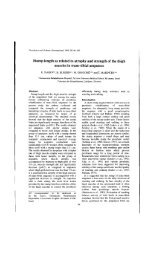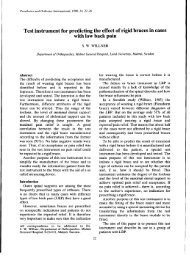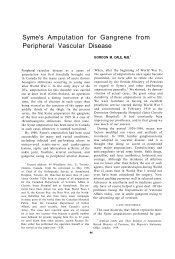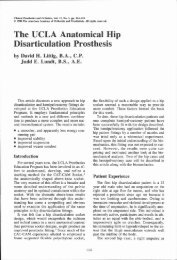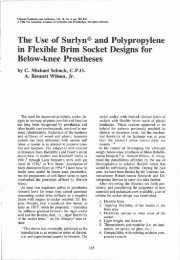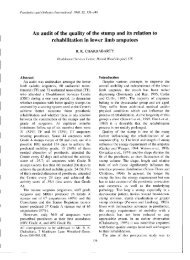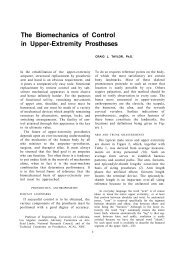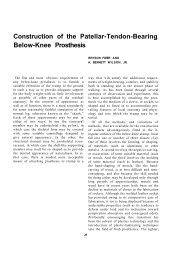Pro-Corn - O&P Library
Pro-Corn - O&P Library
Pro-Corn - O&P Library
Create successful ePaper yourself
Turn your PDF publications into a flip-book with our unique Google optimized e-Paper software.
Figure 3. View showing left foot impression<br />
taken in foam foot impression block. Note "X"<br />
identifying metatarsal head prominence.<br />
Figure 4. Foot impression filled with molding<br />
plaster forming a positive model of the patient's<br />
foot.<br />
by pouring molding plaster into the impression<br />
forms. Modification of the positive model is<br />
necessary to meet the objectives of foot orthoses<br />
for arthritic patients as discussed above.<br />
The longitudinal arch is increased mildly, especially<br />
posteriorly, as proposed by Carlson, et<br />
al., in their technique for modification of the<br />
UCB foot orthosis. 1<br />
This modification meets<br />
the objectives of maintenance and support of<br />
existing arches, provision of eversion or valgus<br />
stability, and distribution of weight bearing<br />
forces. The metatarsal or transverse arch modification<br />
is perhaps most important, and the degree<br />
of this modification in terms of size and<br />
depth parallels the severity of MTP subluxation<br />
and metatarsal head depression. It is frequently<br />
greater than 1/2" in depth. The shape of this<br />
modification should simulate that of prefabricated<br />
rubber metatarsal pads, which are commercially<br />
available in varying sizes and depths.<br />
<strong>Pro</strong>per placement of this modification is critical;<br />
when an existing transverse arch can be<br />
identified, it should be exaggerated. If there is<br />
no identifiable transverse arch, the modification<br />
for this arch in the positive model falls<br />
under the metatarsal shafts, with the dome or<br />
apex of the plaster removal just posterior to the<br />
metatarsal heads, and the proximal edges<br />
blending gradually into the longitudinal arches.<br />
This modification provides support to uplift the<br />
depressed metatarsal heads and reduce trauma<br />
at the push-off phase of the gait cycle. It also<br />
meets the objectives of maintenance and support<br />
of existing arches in some cases, re-establishment<br />
of fallen arches in other cases, and<br />
better distribution of weight-bearing loads. The<br />
final modification to the positive model includes<br />
adding plaster to the plantar aspect of<br />
the PIP joints of the phalanges, which aids in<br />
providing a smooth transition from the MTP to<br />
the phalangeal area of the foot orthosis.<br />
The positive model is now complete and<br />
ready for molding of the base material, PVC<br />
Pelite(tm), which is available in 4' square sheets,



